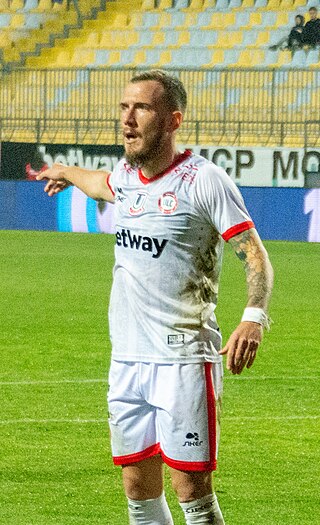Related Research Articles
The 2011–12 Copa Argentina was the third edition of the Copa Argentina, and the first since 1970. The competition began on August 31, 2011 and ended on August 8, 2012. The tournament featured 186 clubs from the top five levels of the Argentine football league system. The winner qualified for the 2012 Copa Sudamericana.
The 2012–13 Copa Argentina was the fourth edition of the Copa Argentina, and the second since the relaunch of the tournament in 2011. The competition began on October 23, 2012. The tournament featured 224 clubs from the top four levels of the Argentine football league system. The winner (Arsenal) qualified for the 2014 Copa Libertadores and the 2013 Supercopa Argentina.
The 2013–14 Copa Argentina was the fifth edition of the Copa Argentina, and the third since the relaunch of the tournament in 2011. The competition began on October 29, 2013. Arsenal was the defending champion, but were eliminated by Instituto in the Round of 32. Huracán won the final and their first title, beating Rosario Central on penalties. By winning the competition, Huracán won the right to play the 2015 Copa Libertadores, and the 2014 Supercopa Argentina.
The 2014–15 Copa Argentina was the sixth edition of the Copa Argentina, and the fourth since the relaunch of the tournament in 2011. The competition began on October 15, 2014. Defending champions Huracán were eliminated by Independiente Rivadavia in the Round of 64. In the final, Boca Juniors won the tournament beating Rosario Central to win their third title. By winning the competition, Boca Juniors won the right to play the 2015 Supercopa Argentina, and Rosario Central, as runner-up won the right to play in the 2016 Copa Libertadores because Boca Juniors had already qualified as Primera División champion. Luis Lune, from Vélez Sársfield (SR), was the highest scorer with 5 goals.

The 2017–18 Argentine Primera B Nacional is the 33rd season of the Argentine second division. The season began in September 2017 and ended in June 2018. Twenty-five teams competed in the league, seventeen returning from the 2016–17 season, four teams that were relegated from Primera División and two teams promoted from Federal A and B Metropolitana.
The 2017–18 Copa Argentina was the ninth edition of the Copa Argentina, and the seventh since the relaunch of the tournament in 2011. The competition began on 19 January 2018 and ended on 6 December 2018.
Lucas Javier Acevedo is an Argentine professional footballer who plays as a centre-back for Greek Super League club Atromitos.
Gonzalo Emanuel Rodríguez is an Argentine professional footballer who plays as a forward for Ferro Carril Oeste.
Gabriel Carlos Compagnucci is an Argentine professional footballer who plays as a right-back or right midfielder for Belgrano.
Marcos Esteban Litre is an Argentine professional footballer who plays as a midfielder or forward for Deportivo Santaní.
The 2018–19 Copa Argentina was the tenth edition of the Copa Argentina, and the eighth since the relaunch of the tournament in 2011. The competition began on 16 January 2019 and ended on 13 December 2019.
Ángel Oscar Prudencio is an Argentine professional footballer who plays as a forward for Independiente Rivadavia.
Neri Alberto Espinosa is an Argentine professional footballer who plays as a midfielder for Club Ciudad de Bolívar.
Mateo Agustín Acosta is an Argentine professional footballer who plays for San Martín de Tucumán.
Jorge Raúl Zules Caicedo is a Colombian professional footballer who plays as a centre-back for Independiente Rivadavia.
Federico Gastón Castro is an Argentine professional footballer who plays as a forward for Independiente Rivadavia.

Augusto Max is an Argentine professional footballer who plays as a defensive midfielder for Gimnasia LP.
Nicolás Eduardo Castro is an Argentine professional footballer who plays as a winger or midfielder for Atlético Tucumán.
Daniel Roberto Garro is an Argentine professional footballer who plays as a midfielder.
The 2019–20 Argentine Primera B Nacional, also known as the 2019–20 Primera Nacional, was the 35th season of the Primera B Nacional, the second tier of Argentine football. The season began on 15 August 2019 and was scheduled to end in May 2020. Thirty-two teams compete in the league, twenty-one returning from the 2018–19 season, four teams that were relegated from Primera División, two teams promoted from Federal A and five from B Metropolitana.
References
- 1 2 3 4 5 6 7 8 9 10 11 12 13 14 15 16 17 "Argentina - L. Bossio". Soccerway. Retrieved 22 January 2019.
- ↑ "Ficha Estadistica de LUCAS BOSSIO". BDFA. Retrieved 22 January 2019.
- ↑ "Lucas Bossio vuelve a San Martín". San Martín. 15 August 2017. Retrieved 22 January 2019.
- ↑ "Bossio y Altuna, dos amigos que se reencontraron en San Martín". La Gaceta. 29 August 2018. Retrieved 22 January 2019.
- ↑ "Νίκη Βόλου: Λούκας Μπόσιο ο τρίτος…". Goal Post. 6 August 2020. Retrieved 30 September 2020.
- ↑ Athletic Carpi, ufficiale l’arrivo dell’argentino Lucas Bossio, seried24.com, 28 January 2022